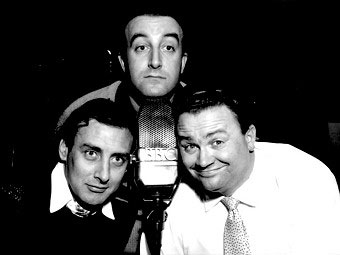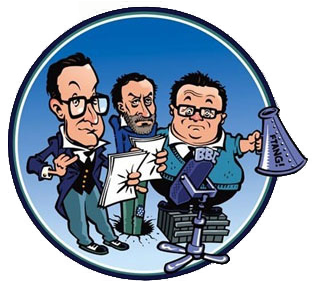The Goon Show was a British radio comedy programme, originally produced and broadcast by the BBC Home Service from 1951 to 1960, with occasional repeats on the BBC Light Programme. The first series (broadcast from 28 May to 20 September 1951), was titled Crazy People; all subsequent series had the title The Goon Show - a title inspired, according to Spike Milligan, by a Popeye character.
The show's chief creator and main writer was Spike Milligan. The scripts mixed ludicrous plots with surreal humour, puns, catchphrases and an array of bizarre sound effects. Some of the later episodes feature electronic effects devised by the then-fledgling BBC Radiophonic Workshop, many of which were reused by other shows for decades afterwards. Many elements of the show satirised contemporary life in Britain, parodying aspects of show business, commerce, industry, art, politics, diplomacy, the police, the military, education, class structure, literature and film.
The show was released internationally through the BBC Transcription Services (TS). It was heard regularly from the 1950s in Australia, South Africa, New Zealand, India and Canada, although these TS versions were frequently edited to avoid controversial subjects. NBC began broadcasting the programme on its radio network from the mid-1950s. The programme exercised a considerable influence on the subsequent development of British and American comedy and popular culture. It was cited as a major influence by the Beatles, Monty Python and the American comedy team The Firesign Theatre.
250 Goon Show episodes were recorded in 10 series, running from May 1951 to January 1960. Many of the earliest Goon Show episodes no longer exist; around 160 still survive. From the start of series 5, the BBC Transcription Services began recording shows for overseas sales, and even commissioned re-recordings of some episodes in a series called "Vintage Goons".
We have cardboard cutouts of 100 of those surviving episodes.
...a little background...
The series was devised and written by Spike Milligan with the regular collaboration of other writers including Larry Stephens, Eric Sykes (who co-wrote most of the episodes in Series 5), Maurice Wiltshire and John Antrobus, initially under the supervision of Jimmy Grafton.

Milligan and Harry Secombe became friends while serving in the Royal Artillery during the Second World War. Famously, Milligan first encountered Secombe after Gunner Milligan's artillery unit accidentally allowed a large howitzer to roll off a cliff, under which Secombe was sitting in a small wireless truck: "Suddenly there was a terrible noise as some monstrous object fell from the sky quite close to us. There was considerable confusion, and in the middle of it all the flap of the truck was pushed open and a young, helmeted idiot asked 'Anybody see a gun?' It was Milligan." Secombe's answer to that question was "What colour was it?" Milligan met Peter Sellers after the war at the Hackney Empire, where Secombe was performing, and the three became close friends.
The group first formed at Jimmy Grafton's London public house called "Grafton's" in the late 1940s. Sellers had already débuted with the BBC, Secombe was often heard on Variety Bandbox, Milligan was writing for and acting in the high profile BBC show Hip-Hip-Hoo-Roy with Derek Roy, and Michael Bentine, who appeared in the first series, had just begun appearing in Charlie Chester's peak time radio show Stand Easy.
The four clicked immediately. "It was always a relief to get away from the theatre and join in the revels at Grafton's on a Sunday night," said Secombe years later. They took to calling themselves 'The Goons' and started recording their pub goings-on with a tape recorder. The BBC producer, Pat Dixon heard a tape and took interest in the group. He pressed the BBC for a long term contract for the gang, knowing that it would secure Sellers for more than just seasonal work, something for which the BBC had been aiming. The BBC acquiesced and ordered an initial series, though without much enthusiasm.
The series had its premiere in May 1951 and audience figures grew rapidly, from around 370,000 to nearly two million by the end of the 17th show. The BBC commissioned a second series during which a number of changes occurred. Bentine left the show, citing a desire to pursue solo projects, although there had been an increasing degree of creative tension between him and Milligan. The musical interludes were shortened, and Max Geldray joined the lineup. Peter Eton, from the BBC's drama department, replaced Dennis Main Wilson as producer. Eton brought stricter discipline to the show's production. He was also an expert at sound effects and microphone technique, ensuring that the show became a far more dynamic listening experience.
Many senior BBC staff were variously bemused and befuddled by the show's surreal humour and it has been reported that senior programme executives erroneously referred to it as The Go On Show or even The Coon Show. The show was very popular in Britain in its heyday; tickets for the recording sessions at the BBC's Camden Theatre (now known as KOKO) in London were constantly over-subscribed and the various character voices and catchphrases from the show quickly became part of the vernacular.] The series has remained consistently popular ever since – as of January 2011 it is still being broadcast once a week by the ABC in Australia, as well as on BBC Radio 4 Extra and continuously on the internet at The GoonShowRadio.
The BBC as part of its archival policy, destroyed most of series one, two, three and some of four. All of series five to ten exist, and the Corporation is gradually releasing them, remastered and restored by Ted Kendall. Source: Wikipedia.